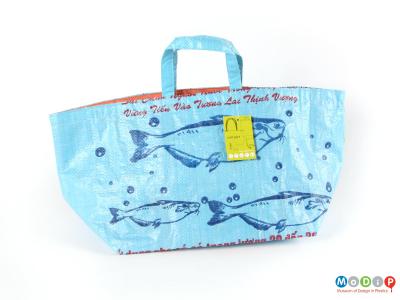The shape and use of a bag lends itself to the upcycling of a variety of materials. Upcycling differs from recycling in that the material is not reprocessed, and therefore retains some of its original elements. These elements become features of the finished product. The woven basket (1) is made of polypropylene (PP) packing straps that are strong and colourful. The shopping bag upcycled from a rice sack (2) is made by an NGO (Non- governmental organisation) offering training and employment to vulnerable women and education to their children, in Cambodia.
The Global Mamas Trashy (3) bag is made from water pouches. The pouches, together with other drinks sachets, account for the majority of litter pollution on the ground in Ghana. By using them to make bags, Global Mamas, a women’s co-operative not-for profit organization assisting women of Africa in attaining economic independence, helps to reduce the problem of litter pollution.
Wyatt and Jack’s bag (4) is part of a collection made from salvaged inflatables and beach toys that have been rescued as part of their Inflatable Amnesty, in an effort to divert as many as possible from landfill. Each product is entirely unique, with the shape of the original item including the areas of damage, dictating the shape of the bag, in order to use as much of the piece as possible.
The Airpaq (5) is made from upcycled seatbelts, airbags, and seatbelt buckles, all sourced from scrap yards. These materials are anti-bacterially washed at high temperatures and the buckles are disinfected before being used. The inspiration for the prototype, designed by Michael Widmann and Adrian Goosses, came from a visit to a scrapyard as part of an assignment on the Strategic Entrepreneurship Master programme in Rotterdam in 2015. Through a crowdfunding campaign the bag was further developed and subsequently the company launched their first collection at Innatex, an international trade fair for sustainable textiles, in August 2018.





